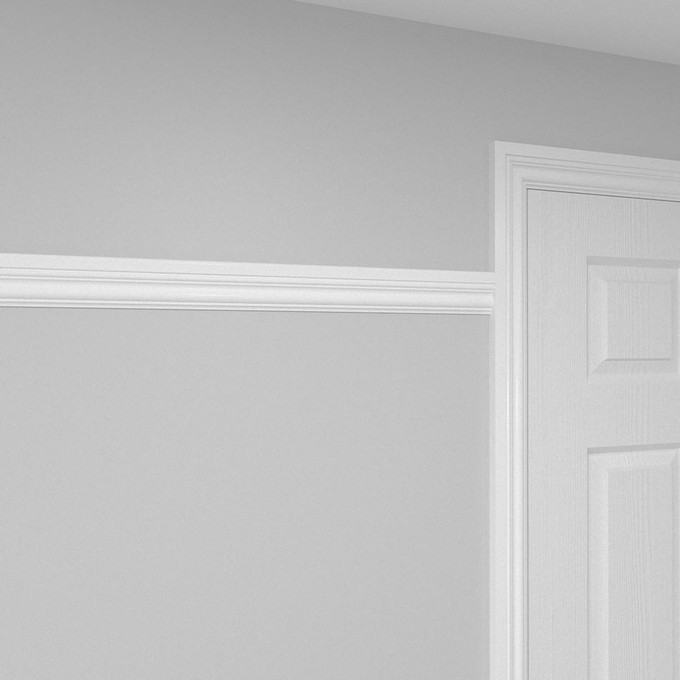
Picture Rail Height Calculator | Find Out The Perfect Height For Picture Rails
Posted by Sultan Khan on 9th May 2025

Picture Rails were once a very practical moulding in traditional homes, but today they are mainly used for aesthetic purposes.
Choosing how high to install a picture rail is difficult, and achieving the ideal height can be a matter of millimetres.
Use our handy picture rail calculator, based on interior design principles, to quickly find out the perfect height for your picture rails.
How High Should The Picture Rail Be From The Floor?
There's no strict rule for how high a picture rail should be. However, certain heights can achieve the desired aesthetic impact.
Originally, picture rails were used to hang artworks, but now they serve as decorative wall features.
The area corresponding to about 70% of the wall height is commonly recommended for picture rail installation.
However, there are many considerations for determining the correct height.
Crown Mouldings and Furniture
When positioning a picture rail, it's essential to consider other architectural elements like crown mouldings, which often adorn the junction between a wall and ceiling. Ideally, the picture rail should sit at least 4 to 6 inches below the crown moulding to create a visual buffer.
Furniture height is another factor. The rail should be high enough to avoid visual interference with tall furniture pieces like bookshelves.
Also consider the architrave and rosettes in your room, as well as the windows. These various elements all play a part in the perfect picture rail height.
Calculating The Picture Rail Height
To find the perfect height for your picture rail, use this simple formula:
Wall Height in mm - 400 mm
Range: 300 mm - 500 mm below the ceiling
For instance, if your wall height is 2400mm (2.4m), subtracting 400mm, gives you 2000mm (2m) as the ideal height for the picture rail.
This places the rail at a height that divides the wall into visually pleasing, harmonious sections. It's high enough to clear furniture and align well with other architectural features, yet not so high that it encroaches upon crown mouldings.
The Method Behind The Measurement - Design Logic
This formula is grounded in principles of aesthetic harmony and proportionality.
- The ratio creates a balanced division of the wall, making it visually appealing.
- This height usually complements the proportions of doors and windows in a room.
- Placing the rail too low or too high could disrupt this balance, hence the mathematical approach.
- The ratio can be adjusted slightly to suit specific room features while maintaining the overall effect.
- This method aligns with interior design principles that favour mathematical ratios and harmony.
Your Home - Your Rules
You may want to install your picture rail lower or higher than our recommendation, that's perfectly fine.
Our recommendation is our own, based on interior design principles and the golden ratio - a mathematical proportion found in nature, that is aesthetically pleasing to the eye, to serve as a general guideline for the installation height.
You know your home best, experiment with the height of your picture rail and get second, third and even fourth opinions if you're unsure!
Dado Rails
Also see our Dado Rail Height Calculator to find out the perfect height for your dado rails!
Are picture rails a good idea?
Yes, picture rails can be a very good idea. They provide an attractive method to display and change artwork regularly. Picture rails prevent nail holes in walls and make rearranging artwork simple. They give a clean gallery aesthetic. Picture rails have been used for centuries and remain a classic decorating element.
What is the point of picture rails?
The main points of picture rails are to neatly display artwork and photographs without damaging walls, allow easy repositioning of hung items, and give a cohesive gallery-like look. Picture rails eliminate the need to drill multiple holes. They provide an anchor to hang artwork from with hooks or cords. Picture rails help decorate a room with visual interest.
What is the difference between a dado rail and a picture rail?
The main difference is that a dado rail is a horizontal molding fitted about halfway up a wall to take decorative platings or shelves. A picture rail is specifically for hanging pictures, higher up a wall, usually about 60 inches from the floor. Dado rails have a more functional use while picture rails are solely decorative.
Does a picture rail make a room look bigger?
Yes, picture rails can help make a room look bigger in a few ways. The long horizontal line draws the eye out, giving the illusion of width. The gallery-like display adds height. Angled pictures lead the eye up dynamically. The rail limits wall decor to select areas, avoiding clutter. Overall, thoughtfully using picture rails enhances spaciousness.

